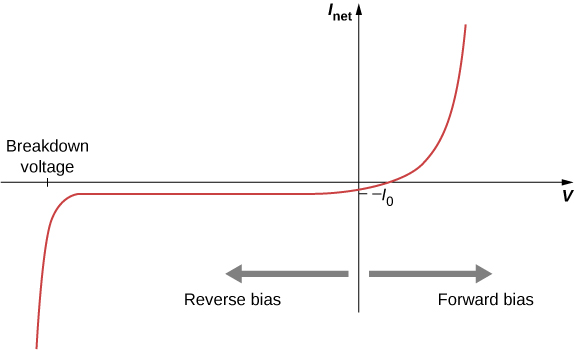| << Chapter < Page | Chapter >> Page > |
We can estimate the mathematical relationship between the current and voltage for a diode using the electric potential concept. Consider N negatively charged majority carriers (electrons donated by impurity atoms) in the n -type material and a potential barrier V across the p-n junction. According to the Maxwell-Boltzmann distribution, the fraction of electrons that have enough energy to diffuse across the potential barrier is . However, if a battery of voltage is applied in the forward-bias configuration, this fraction improves to . The electric current due to the majority carriers from the n -side to the p -side is therefore
where is the current with no applied voltage and T is the temperature. Current due to the minority carriers (thermal excitation of electrons from the valence band to the conduction band on the p- side and subsequent attraction to the n -side) is , independent of the bias voltage. The net current is therefore
A sample graph of the current versus bias voltage is given in [link] . In the forward bias configuration, small changes in the bias voltage lead to large changes in the current. In the reverse bias configuration, the current is . For extreme values of reverse bias, the atoms in the material are ionized which triggers an avalanche of current. This case occurs at the breakdown voltage .

The current with no bias is related to the reverse saturation current by
Therefore
[link] can be written as
This ratio is much greater than one, so the second term on the left-hand side of the equation vanishes. Taking the natural log of both sides gives
The temperature is therefore
Check Your Understanding How does the magnitude of the forward bias current compare with the reverse bias current?
The forward bias current is much larger. To a good approximation, diodes permit current flow in only one direction.

Notification Switch
Would you like to follow the 'University physics volume 3' conversation and receive update notifications?